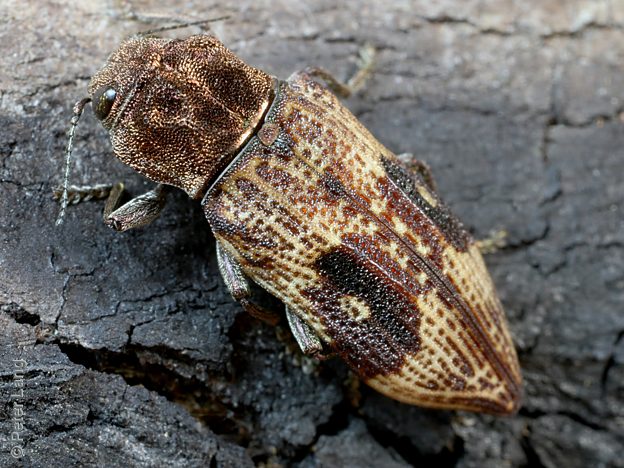
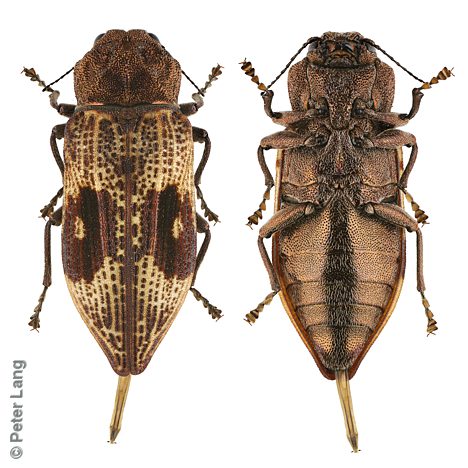
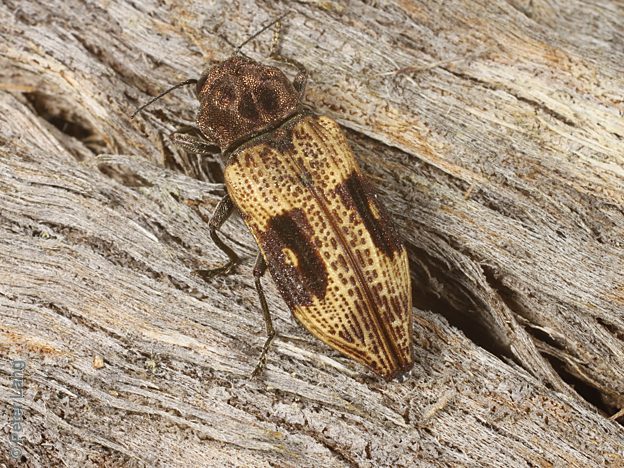

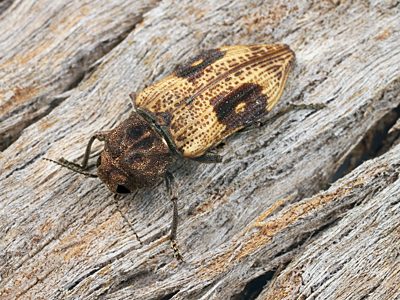
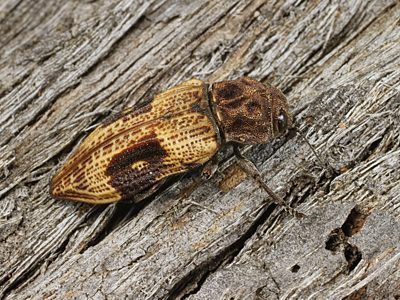
size¹:
×
6.0 mm






| male | female | |||||
|---|---|---|---|---|---|---|
| L1 | 14.2 | n = 1 | 16.6 | 16.5 – 16.6 | n = 2 | |
| L2 | 13.9 | n = 1 | 16.2 | 16 – 16.4 | n = 2 | |
| W | 5.4 | n = 1 | 6.2 | 6.1 – 6.4 | n = 2 | |
| Legend | L1 | length from clypeus/frons to elytral apex (mean, range, sample size) |
| L2 | length from anterior of edge of eyes to elytral apex | |
| W | maximum width with elytra fully closed |
A distinctively marked beetle with straw-yellow and dark brown colouration and sculpted pronotum; nothing else in SA resembles it.
This is a south-eastern Australian species which in SA is confined to the higher rainfall areas.
| Legend | P.J.Lang collection vouchered records | |
| other private collection or museum specimens, or sightings |
|
|
|
|
|
|
|
|
|
|
|
|
|
||||||||||||||||||||||||||||||||||||||||||||||||
|
|
|
|
|
|
|
|
|
|
|
|
|
||||||||||||||||||||||||||||||||||||||||||||||||
| Jul | Aug | Sep | Oct | Nov | Dec | Jan | Feb | Mar | Apr | May | Jun |
| Legend | ||
9 | number of active beetles, actually recorded in that quarter-month | |
| actual count > 2 (median) | ||
| actual count <= 2 (median) | ||
| beetles | sites | SA regions¹ | family | position on host plant | ||||
| Eucalyptus sp. | 9 | 4 | SL, SE | M | ||||
| Eucalyptus obliqua | 2 | 1 | SL | M | ||||
| *Eucalyptus gomphocephala | 1 | 1 | SL | M | ||||
| Eucalyptus viminalis ssp. viminalis | 1 | 1 | SL | M | ||||
| Pteridium esculentum ssp. esculentum | 1 | 1 | SL | |||||
| Xanthorrhoea sp. | 1 | 1 | SL | X |
| Legend | beetles | count of beetles collected from, or sighted on, host plant taxon |
| sites | count of major sites (unique 10 km grid cells +/- some distinct approximate localities) | |
| * | indicates alien (non-native) plant occurrences, either wild or planted (the species may be alien in SA, or native in parts of its SA range) | |
| Plant names in green are hyperlinked to a matching host species page with plant photos. | ||
| Code | beetles | % | host plant taxa | |
| M | Myrtaceae | 13 | 87% | 3 |
| U | Unmatched | 1 | 7% | 1 |
| X | Xanthorrhoeaceae | 1 | 7% | 1 |
| position | beetles | sites | ||
| on foliage or non-flowering plant | 6 | 2 | ||
| on plant (unspecified) | 4 | 2 | ||
| other | ||||
| on bark | 2 | 1 | ||
| on dead branch | 1 | 1 | ||
| on trunk | 1 | 1 | ||
| under bark | 1 | 1 | ||
Adults are often found on the trunks of Eucalypts with rough bark, including Stringybarks as well as species where the rough bark is mainly basal. One SA Museum specimen was collected from a planted Tuart, Eucalyptus gomphocephala, in Adelaide Hills. It is more commonly found on there on Messmate Stringybarks (E. obliqua).
Tepper 1887 reported the Stringybarks E. obliqua and E. baxteri (as E. capitellata) to be larval hosts, noting that 'the larva lives in the dry corky bark'. Another SA Eucalypt species, E. goniocalyx (Long-leaved Box) was identified as a larval host in NSW by Turner & Hawkeswood 1995a who found dead beetles found in dry bark and larval and pupal chambers in bark and sapwood.
| ¹ Legend | regions | SA State Herbarium regions (map) EA: Eastern, EP: Eyre Peninsula, FR: Flinders Ranges, GT: Gairdner-Torrens, KI: Kangaroo Island, LE: Lake Eyre, MU: Murray, NL: Northern Lofty, NU: Nullarbor, NW: North-Western, SE: South-Eastern, SL: Southern Lofty, YP: Yorke Peninsula |
| size | The ellipse is the correct size when printed, indicative on a desktop screen, and likely to be wrong on a mobile device. |